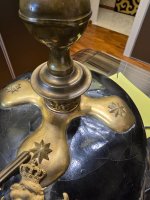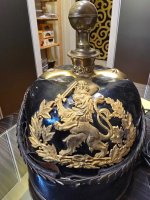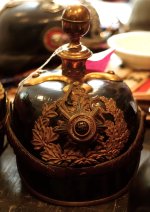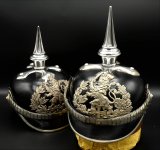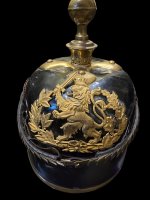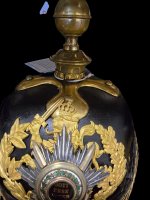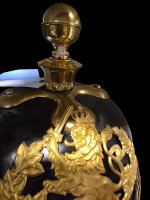You are using an out of date browser. It may not display this or other websites correctly.
You should upgrade or use an alternative browser.
You should upgrade or use an alternative browser.
Hessian helmet Stars ot Studs
- Thread starter Amybellars
- Start date
Sandmann
Well-known member
Here are my information about the helmets of the LIR115:
Foundation Day: 11.03.1621
Foundation Day: 11.03.1621
Helmet emblems:
- A rising Hessian lion with a double tail, striding to the right in the heraldic sense. He wears a crown on his head and holds a raised sword aloft. The lion was surrounded by a double wreath of laurel leaves and oak leaves open at the top. Before 1897, the Hessian lion of the LIR115 was surrounded only by a simple wreath of laurel and oak leaves. Until 1867, there were also Pickelhauben with a Hessian lion without foliage, which was worn by Hesse-Homburg and Hesse-Kassel. However, these states lost their sovereignty in 1866.
- By AKO from 05.12.1871, an award ribbon with the year "1621" was placed above the lion. It stood for the year in which the original regiment was formed.
- By AKO from 25.01.1897 the fitting color of the LIR115 was changed to silver.
- By AKO from 23.11.1897, the regiment was allowed to wear the 8-pointed Hessian Grand Cross Star of the Order of Louis in silver. In the circular center of the Star was the inscription "GOTT, EHRE, VATERLAND“ (GOD, HONOR, FATHERLAND), framed in laurel leaves.
- For officers, the emblems were gilded or silver-plated and in general more finely crafted. The spaces between the crown bars on the lion's head, for example, were real open spaces, whereas they were only implied on the enlisted men's emblems. The star on the officers' fittings was also silver-plated and refined with enamel.
Fittings and helmet visors:
- The Hessian Pickelhauben always had a cruciform spike base. The rear spine on the Hessian helmets was usually attached with 2 visible fasteners, just like the dragoon helmets of the Prussians. Unlike the Prussian helmets, the Hessian helmets retained the rear spine between 1867 and 1871 too. Also unlike the Prussian helmets, the Hessian helmets M1887 retained the front visor with metal trim. With the M1895, the rear spine of the foot troop enlisted men's helmets received a ventilation slider in the upper third. Smooth rear spines were now used, most likely due to the ventilation slider. However, a smooth rear spine was also used more frequently on officers' helmets from 1897 onwards.
- The front visors of the officers were green on the underside, the rear visors red. The neck of the cruciform spike base had no pearl ring for the officers of the regiment. In Hesse, only field artillery officers wore such a decoration.
- By AKO from 25.01.1897, the color of the fittings had already changed from gold to silver.
- The cruciform spike bases on Hessian officer helmets were fastened with half-round heads, just like those of the enlisted men. However, since an AKO dated 25.11.1897, on the birthday of the Grand Duke, the LIR115 officer's cruciform spike base was attached to the helmet with silver stars. The stars were only worn by the officers of the LIR115!
Chinscales/Chinstrap:
- Until 1897, the chinscales of the Hessian infantry were curved.
- By an AKO dated 25.11.1897, the LIR115's chinscales should be changed to flat. However, contrary to the regulation, the officers often retained their curved chinscales.
- With the introduction of the M1887, the chinstrap made of black leather was introduced for the infantry, replacing the chinscales. Officers and non-commissioned officers continued to wear the chinscales on their helmets, but the non-commissioned officers' chinscales adopted the new fastening method. Unlike in Prussia, the chinstrap in Hesse had to be replaced by the chinscales for parades or in the garrison. On the M1887, the chinstrap and the NCO's chinscales were still attached to the helmet with a hook/eye fastening, but this meant that the chinstrap was too often lost.
- For this reason, the fastening method for enlisted men and non-commissioned officers was soon replaced by the cylindrical M1891 rosettes in 1891.
- With the introduction of the helmet M1915, the officers now also used the M1891 fastening system for the chinscales, whereby the M91 rosette cylinders were almost invisibly hidden by a cover that was integrated into the chinscales.
Cockades:
- The cockade of the Grand Duchy of Hesse was white with 2 red rings. Until 1897, it was the only cockade worn on the helmet on the right side. The officers' cockades were different from the Prussian single-pieced parts. They were cockades in ancient Hessian style, which was a fanned disc with smooth edges, silver-plated with 2 red rings.
- By AKO from March 22, 1897, the imperial cockade in red-white-black was then generally introduced. Like the national cockade, the officers' imperial cockade was made up of 2 parts and had a silver-plated affixed ring instead of the white painted ring. However, it also existed in the old Hessian style, as a fanned disk in red with a black edge and a silver-plated ring. It was a tribute to the founder of the Reich, Kaiser Wilhelm I, who would have been 100 years old on this day. From then on, all Hessians wore the state cockade on the left side of the helmet and the imperial cockade on the right.
To Parades:
- For parades, the members of the LIR 115 wore a black hair bush.
- The musicians wore a red hair bush.
Last edited:
Amybellars
Well-known member
So conclusion is..studs not stars.
Yup, studs no stars!
James
James
John Josef
Well-known member
By regulations it should be studs. I believe the traces of studs being used on the helmet are visible too.
Eyes like an eagle
Really good to see everyone work together and provide excellent information.
KAGGR#1
Well-known member
Here are mineShould it be studs or stars as retainers?
Thank you
View attachment 59649View attachment 59650
Regards
Amy Bellars
Helmets do not always conform to regulations
Steve
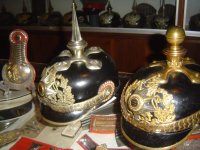
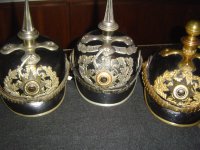
Here are mine
Helmets do not always conform to regulations
SteveView attachment 59726View attachment 59727
But yours obviously do, Steve.
Jvpi
Well-known member
Hi Steve, your helmets actually followed the regulations quite strictly. The studs on officer's helmet of IR115 were changed to stars, as Sandy stated above, in 1897. I don't know that the change was made that early. I thought it was sometime after 1910 since I've seen examples in post 1897 style still using studs...Here are mine
Helmets do not always conform to regulations
Steve
ccj
Well-known member
I like the small stars adorning Amy’s helmet. It appears to align with the majority of Hessen helmets I’ve observed featuring stars instead of studs. I’ve also seen LGR115 helmets with studs and stars. I wonder if those with studs are NCOs or Fähnrichs. Until now, I just thought both to be officer.
Jvpi
Well-known member
The breast star with swords was awarded to DR23 in 1915.I wonder if they also had such a change when they were awarded their order and swords.
Last edited:

